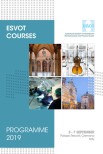In this paper a case of periosteal proliferative polyarthritis is described in an 11-year old, female Siamese cat, that was admitted to the Surgery Clinic of the Veterinary School, A.U.Th., with a 6-month history of nonweight bearing lameness of the left thoracic limb. At physical examination, restricted range of motion of the left elbow joint, local swelling and pain were detected. In the radiological examination of the affected joint the main finding was an extensive periarticular and irregular periosteal new bone formation. The results of the complete blood count and routine serum biochemistry were within normal limits and the cat was serologically negative for FeLV and FIV. Synovial fluid examination showed a lymphoplasmacytic pleocytosis, while the bacterial culture was negative. Prednisolone given at an anti-inflammatory dose for two consecutive weeks resulted in a marked improvement of the clinical sings. However, two months after the end of the treatment lameness reappeared, but this time in the contralateral thoracic limb, due to the involvement of the same joint. Radiology revealed the same type of lesions in the right elbow joint, while the left became ankylosed. Again, prednisolone given at an immunosuppressive dose for two weeks gave only moderate improvement in both the clinical conditions and the radiological changes in the animal. For this reason azathioprine at the dose of 1 mg/kg BW, every 48 hours, was added to therapy that lasted for 5 months. Transient mild leukopenia, that resolved after decreasing the dose of azathioprine by 25% was the only adverse side effect noticed. At the end of the treatment, regression of the radiographical lesions in both elbows enabled the cat to walk with a stilted gait despite the development of joint ankylosis bilaterally. The disease was kept in remission during the 12-month follow up period.
A case of periosteal proliferative polyarthritis in a cat
Date
2006
Journal
EJCAP
Volume
16
Number
1
Pages
21-25









